Rosella parrot: description, types, rules of maintenance
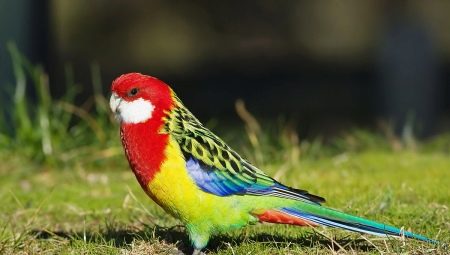
Many people have parrots. To avoid possible problems with your pet, you need to carefully study the features of each specific species. This also applies, of course, to the Rosells.

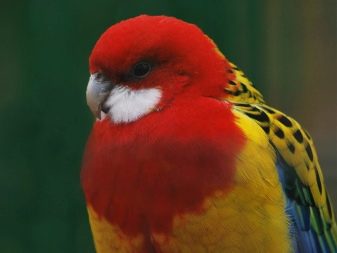
Description
This type of bird stands out among other parrots with its unusually bright plumage. It has a scaly structure. Rosella lives even in city parks, which clearly shows the level of adaptability of this parrot to difficult conditions. Connoisseurs of wildlife are happy to have a rosella. The popularity of this species is associated with:
- tenderness and volume of voice;
- the melody of whistlers and flute echoes;
- ease of learning;
- external beauty.



What is not less important, Rosella is also distinguished by a very flexible character. It is easy to establish full contact with her. The bird does not have any special requirements for keeping. However, she does not speak very well either. Even if you strictly follow the special recommendations for training, Rosella can learn no more than 10 words.
With the usual neat content, the vocabulary will be half as much. But the singing voice of Rosella is very pleasant. The intellectual level of the parrot provides him with the ability to imitate other birds without any problems. Sometimes even other sounds of nature are reproduced.
It should be borne in mind that rosella, with rare exceptions, behaves aggressively towards other poultry.
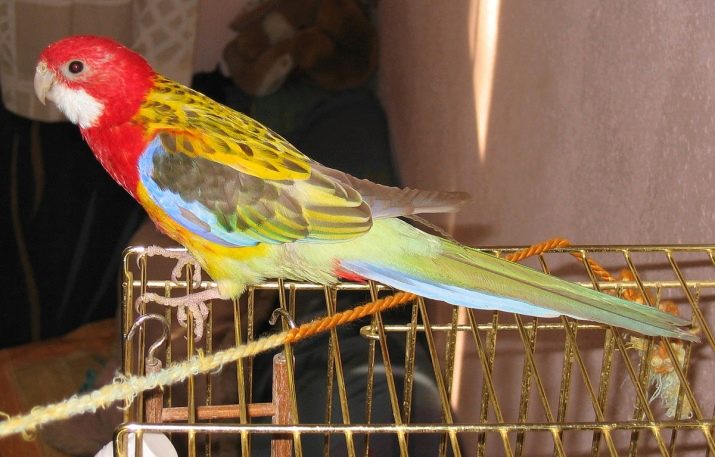
The size of the parrot is average (body length is 0.25-0.35 m). All species of this genus have a rather wide, stepped tail of 4 feathers. The surface of the beak at the very tip contains the original notch. Large spots form on the cheeks:
- yellow;
- blue;
- milky white.


Determining the sex of a rosell is very difficult. Sexual dimorphism is not very pronounced. Even fairly experienced breeders sometimes buy birds of the same sex by mistake. The color and size of the individuals are exactly the same. It is necessary to pay attention, first of all, to the size of the head and beak (in males they are larger).
Rosella can be 15-20 years old. In any case, if the usual conditions of home maintenance are observed. With a successful combination of circumstances, you can expect that the parrot will live more than 25 years. Of course, this life expectancy is ensured only with adequate nutrition.
The vast majority of rosellas have bluish wings covered with black spots. The wings themselves reach a maximum of 0.1 m in length. The flight characteristics of the bird are low: they can fly only a short distance, often flapping their wings. According to the existing ornithological classification, there are 7 varieties of rosellas.

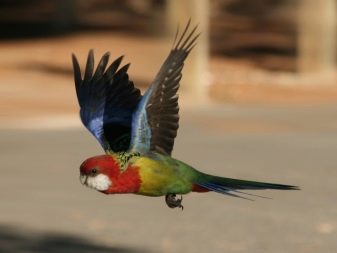
In the wild, the parrot eats a variety of food. The diet may contain:
- fruits;
- berries;
- grains of cereals and other crops;
- field, forest and garden greens.

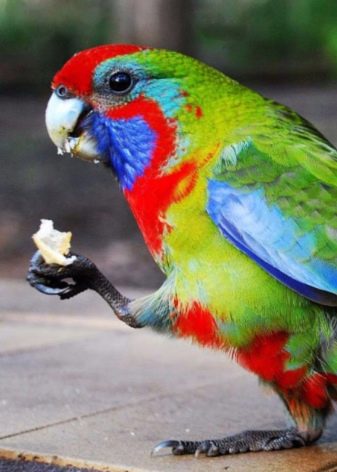
Views
The difference between the breeds of rosella is expressed mainly in the color of the feathers. Their other main characteristics are more or less the same.
- The pale-headed type reaches 0.33 m in length... The back is covered from above with a black feather with a yellow border. The light yellow head is favorably set off by the white cheeks. On the back below, on the main part of the wing and above the tail, the feathers are blue (or blue with a greenish tint). The red undertail looks very attractive.

- Green rosellas can grow up to 0.36 m. The plumage is colored very differently, but in most cases the bird's body is brown on top, surrounded by a blue border. The neck, breast and crown of the head are yellow-green, while the throat is colored blue and the forehead is colored red.

- Red (they are also penant) rosellas grow up to 0.36 m, their color is very variegated. The head and chest are colored red, and the cheeks are bluish-white. The bottom of the rosella is green in color, while it has a black back, blue wings and a white and green tail.
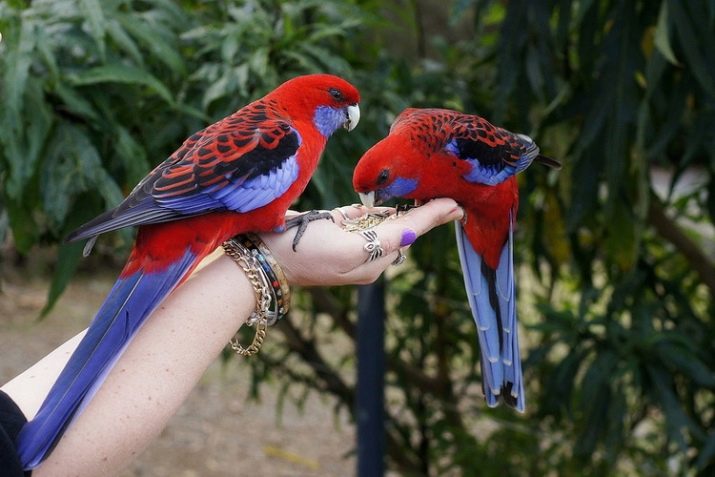
- Black-headed rosellas are distinguished by a black and yellow feather covering:
- upper back;
- shoulders;
- the back of the head.
On the black head, white cheeks with a blue border are clearly visible.

- The yellow-cheeked rosella is the smallest in size. She is appreciated for her amazingly beautiful plumage.

- The pale-headed rosella inhabits mainly the northeastern part of Australia. The population of this species is quite large in Queensland and New South Wales, a certain number of individuals are found in Tasmania. The red rosella can be found in the southern and eastern parts of Australia, on the adjoining islands. The yellow-cheeked species has mastered the same regions.

- And black-headed parrots can be seen anywhere on the northern coast of Australia. There, optimal conditions have been created for them (savannah, where you can eat seeds). Birds often visit sunflower and corn fields, they can get food even on vegetable plantations. The pale-headed parrot, along with such food, can exterminate small insects.
For nesting, rosella uses tree hollows, empty areas inside thick branches and other shelters.

- The variegated rosella is divided into three subspecies, which can be found in Tasmania and southeastern Australia. The size of the bird is relatively small (the length is no more than 0.32 m, the wing is up to 0.11 m). The bird is distinguished by its graceful plumage. The feathers are black on the top of the back, but each has a yellow-green border. The same yellow-green coloration is characteristic of the lower back as a whole. The bright red neck and chest look very attractive.
On the belly and above the tail, the feathers are painted in a light green tone. The wings have a lilac-blue tone, diluted with black splashes. The tail feather is painted blue with the tips slightly lighter than the main part.

- The variegated parrot inhabits open areas of the area. It feeds on seeds of both wild and artificially grown plants. At the same time, the bird fights weeds and harmful insects. She can nest in:
- cavities of large branches;
- empty rabbit holes;
- nests of other birds;
- convenient places on a post or hedge.
Keeping a variegated rosella at home or in a zoological corner is very easy. The parrot quickly gets used to contact with people and does not scream too loudly. However, the manifestation of aggression towards birds of other species is likely.


- The ruby look was named for its graceful coloration. Feathers have yellowish patches. This rosella is pretty good at imitating human speech. Life expectancy can reach 30 years.


- Rosella is not actually found in nature.... In any case, there is absolutely no mention of it in scientific sources.
Anyway, all types of rosella can only exist normally in conditions similar to those in Australia.

Content rules
Caring for rosella at home is clearly more difficult than it might seem at first. Such a parrot is shy. Careless handling can cause irreparable mental harm.
It is categorically unacceptable to catch the rosella with your hands. Usually, special soft nets are used for this. Another way is to lure food from the main cage into a carrying bag.
Already at home, you need to remove the perch from the carrier, then move the carrier to the open home cage. The bird itself will fly there. It is also important what this cell will be. In the wild, Rosella loves to fly from one branch to another, so she needs maximum space at home.
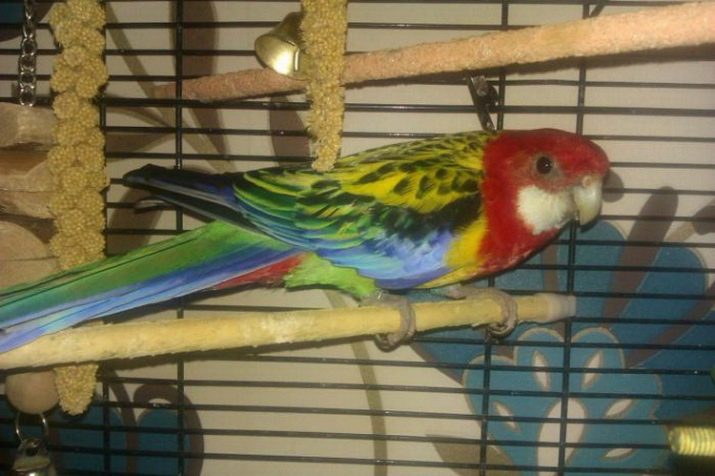
It is also desirable that inside the cell there is more perches. Already at the very tender age, the Australian parrot should actively fly. Keeping it locked up constantly, the owners only increase the likelihood of disease.
The only acceptable filler materials for the enclosure are dry sand or recently filed sawdust. Fillers should be changed as often as possible.
Rosella differs from other parrots in that does not tolerate high humidity. The cages are placed in dry, draft-free rooms. It is best if the room is equipped with air conditioning, adjusted to 60% humidity. Rosellas just love to splash and swim in clear water. The reservoir with it must stand in the cage continuously.


Speaking about caring for these parrots, including food, one cannot ignore their characteristic feature - conservatism. Both sudden changes in location and changes in food can cause great damage to the bird. Rosella is extremely bad at handling noises, especially music. In a family where there is constant scandal, the parrot will feel uncomfortable. It is undesirable to start it and lovers of noisy feasts.
You need to feed the bird only with fresh food. To do this, use:
- vegetables;
- fruits;
- cereal mixes for medium-sized parrots.


The Rosellas are eager to eat bananas. But only if they were initially accustomed to such food. The bird will stubbornly turn its beak away from everything else. Rosella eats any greens. With the help of a green salad made from moistened leaves, you can not only feed your pet, but also give him water.
In the wild, Rosella preys on worms, insects, and various larvae. There is no need to provide them with such food in captivity. Moreover, it is impossible to get exactly the species necessary for birds in our country. Boiled eggs and low-fat cottage cheese are good substitutes. You should not experiment with the rest of the food.


How to tame a parrot to your hands?
It is quite possible to teach a rosella parrot to sit on your hand. The main thing is to take into account the natural conservatism of these birds and not force the process. They will spend about a month on mastering the house. Then you should carefully approach the cage every morning and start feeding.You will have to devote a lot of time to the Rosells every day, otherwise they will not be tamed.
Usually in 1-2 months you can achieve an already calm, fearless landing on the shoulders. In this case, you must definitely trust the bird. If he wants to take off from his shoulder and flutter around the house, let him do so.
Sudden movements and even just raising the voice are unacceptable. They will only irritate Rosella.

Breeding features
A nesting house measuring 0.25x0.25x0.4 m is built for birds in the spring. Peat and sawdust are poured inside. This is the most favorable breeding ground. Important: birds can also build their own nest. There would be material for such a construction.
To regulate the reproduction of parrots, you can deliberately deprive them of the ability to build a nest. But even with strict adherence to the basic rules, you can not wait for the appearance of chicks. The main reasons for their death are:
- oxygen deficiency;
- low humidity;
- clogging of the shell surface.


Rosella leaves the nest when incubating only for food intake. Food, as well as water, should be placed closer to the bird. The hatched chicks are blind, but they already have thick fluff. Feeding actually falls on the owners. Rosella will be able to eat independently only at the age of one month.
The air temperature when keeping rosellas should be kept at around 20-25 degrees. You need to take care of a constant supply of fresh air. Daylight hours should be at least 18 hours. In winter, the lack of light is compensated artificially.
Important: giving the bird the opportunity to fly around the apartment, it is necessary to close all the vents in order to prevent flight.

Disease prevention
Despite the resistance of the body in general and immunity in particular, rosellas can still get sick. The main danger is stress. If the bird has undergone it, then the threat of the manifestation of the pathogenic properties of any microorganism is very high. If injuries are caused due to stress, treatment is impossible in principle. The only way to fight is to maintain optimal rest.
It is possible to exclude infection with respiratory mycoplasmosis if:
- systematically clean up the cage;
- give only clean water;
- take care of the quality of feed;
- periodically process the cage with quicklime.


Rosellas delivered from European countries are often infected with circovirus. In the EU, veterinary control on the import of animals is much stricter, therefore, illiquid assets are systematically dumped into our country. Due to the disease, the plumage of the bird is disturbed, the shape of the beak is distorted. Even worse, the bird's immunity and nervous tissue suffer.
When buying, you must carefully find out the country of origin of the rosella. It is useful to inquire about the sanitary accompanying documents. You can reduce your risk of infection if:
- carefully remove scales and droppings;
- give only high quality proven food;
- prevent contact of sick and healthy birds.

Since Rosella is curious and very mobile, she can be severely injured. There are no ways to prevent injuries. Only a veterinarian ornithologist can help. Methods for the prevention of vitamin deficiencies and parasitic diseases are the same as in other parrots. Periodic veterinary examinations are highly recommended.
Maintaining normal living conditions for birds is possible thanks to air humidifiers and ionizers. To strengthen the body of rosellas parrots use conventional vitamin preparations. Store them in the refrigerator. To start treatment on time, you need to closely monitor the changing behavior of the rosella.
To prevent intoxication, it is necessary to remove parrots from the room with any coloring and disinfection, during deratization, during repairs and cleaning using toxic substances. Rosella can be poisoned by a wide variety of house and garden plants. Therefore, it is necessary to keep the parrot away from all vegetation that is not known to be safe for this species.
The biggest threats are yew, dope, acacia and golden rain.


Wild-growing dope, henbane, nightshade, belladonna and raven are also toxic. Indoor cultures are advised to beware of:
- oleander;
- periwinkle;
- raven eye;
- any kind of dieffenbachia.

Owner reviews
Despite all the difficulties in caring for a rosella, a parrot can become a real decoration in any home. It should be borne in mind that even with long-term maintenance, this bird will not become tame to the end. Contacts with the outside world are rather painful for her. If the bird hears a stranger, unfamiliar voice, then it tries to consider the speaker, twisting its head around. Some say that even with the appearance of households in atypical clothes, Rosella will freeze and wait for the consequences of an unusual situation.
She won't sing too often, mostly when there is no one else in the room. Tense screams smoothly emerge from the melodic singing.
Important: this species of parrots gnaws everything. This must be taken into account when choosing cages and toys, any accessories. Sometimes Rosella will “deal” with a recalcitrant object for several days in a row until she takes a bite of it.

For taming the rosella parrot, see the next video.








